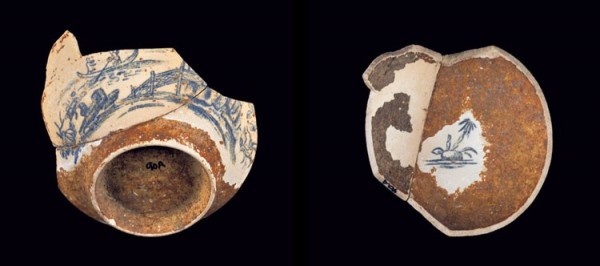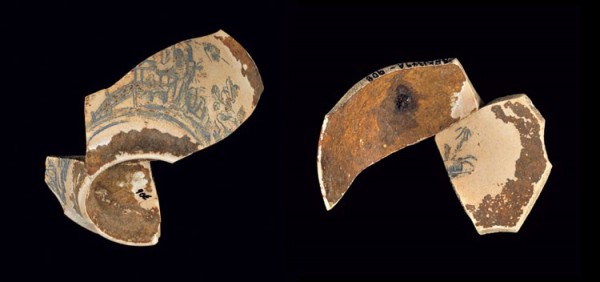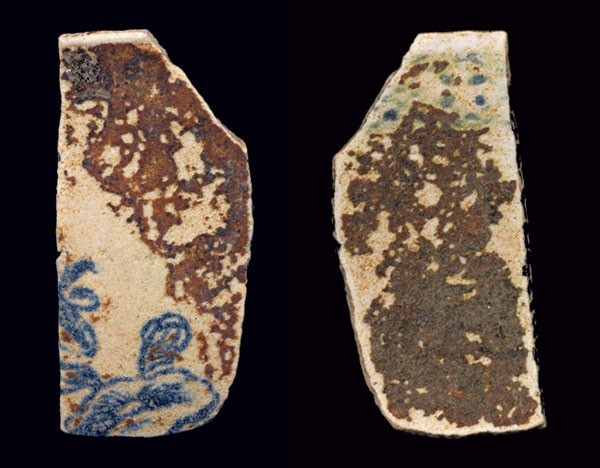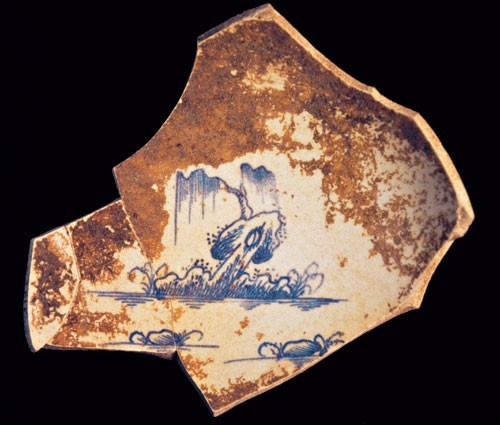
Teabowl fragments, John Bartlam, Cain Hoy, South Carolina, 1765–1770. Soft-paste porcelain. (Courtesy, South Carolina Institute of Archaeology and Anthropology; photo, Stanley South.) This painted decoration occurs on several teabowls and was dubbed “Bartlam on the Wando.” A sherd from a similar teabowl is overlain for comparison, to show the similarities in the painted design.

Teabowl fragment, John Bartlam, Cain Hoy, South Carolina, 1765–1770. Soft-paste porcelain. (Courtesy, South Carolina Institute of Archaeology and Anthropology; photo, Gavin Ashworth.) Note the deteriorated glaze resulting in a thick brown patina found on many of the Bartlam porcelain fragments. This material was carefully scraped away to reveal the underlying blue decoration.

Teabowl fragment, John Bartlam, Cain Hoy, South Carolina, 1765–1770. Soft-paste porcelain. (Courtesy, South Carolina Institute of Archaeology and Anthropology; photo, Gavin Ashworth.)

Teabowl fragment, John Bartlam, Cain Hoy, South Carolina, 1765–1770. Soft-paste porcelain. (Courtesy, South Carolina Institute of Archaeology and Anthropology; photo, Gavin Ashworth.)

Teabowl and saucer fragments, John Bartlam, Charleston, South Carolina, probably 1771–1773. Soft-paste porcelain. (Courtesy, Charleston Museum; photo, Stanley South.) These fragments excavated from sites in Charleston exhibited the same characteristic brown patina as Bartlam’s Cain Hoy porcelain. It is probable these examples were made at Bartlam’s “POTTERY and CHINA manufactory” in Charleston, which appears to have operated between 1771 and 1773, before he moved to Camden.

Teabowl fragment, John Bartlam, Cain Hoy, South Carolina, 1765–1770. Soft-paste porcelain. (Courtesy, South Carolina Institute of Archaeology and Anthropology; photo, Gavin Ashworth.)

Bowl fragment, John Bartlam, Cain Hoy, South Carolina, 1765–1770. Soft-paste porcelain. (Courtesy, South Carolina Institute of Archaeology and Anthropology; photo, Stanley South.)
John Bartlam, a Staffordshire master potter, immigrated to the Charleston area in South Carolina area sometime about 1763 to establish a manufactory of refined pottery.[1] Bartlam’s first attempt to produce ceramics in America began in a settlement in St. Thomas Parish known in the eighteenth century as “Cain Hoy” (now Cainhoy), on the north bank of the Wando River, north of Charleston. This summary of the project introduces the events that led to the recovery of examples of Bartlam’s ceramics made at his Cain Hoy enterprise, including the unexpected discovery of evidence of his soft-paste porcelain.[2]
John Bartlam’s South Carolina factory was significant enough to concern Josiah Wedgwood, who saw it as an attempt to take over the earthenware market in the American colonies from England.[3] Bartlam found good clay at Cain Hoy and was beginning to establish his operation in 1765. On September 28, 1765, the South Carolina Gazette reported that John Bartlam had promised “To make every kind of earthenware that is usually imported from England.”[4] In May 1768 he mortgaged his factory to further finance the undertaking, and within a year advertised for young African Americans to work as apprentices in the new business. By 1771 he claimed to be making “Queens Ware” and “china” at a manufactory located on Old Church Street in Charleston, and advertised for six apprentices.[5]
By 1773 his factory had failed and his foreman, William Ellis, went to Salem, North Carolina, where he taught the potter Rudolph Christ how to make queensware and tortoiseshell ware as well as salt-glazed stoneware.[6] By 1774 Bartlam had moved his factory to Camden, South Carolina, and was exporting to Charleston his “Queen’s Ware,” which was said to be “equal in quality and appearance, and can be afforded as cheap, as any imported from England.”[7] He died in 1781, and his property in Camden was seized and sold for debts in 1788.[8]
In the 1960s I carried out excavations, assisted by Bradford L. Rauschenberg, in the Moravian settlements of Bethabara and Salem, North Carolina, and found examples made in the 1780s of the type of mold-made creamware Ellis had taught Christ to make in 1773.[9] This ware caused something of a sensation among ceramic scholars because no examples of the type of tortoiseshell ware and creamware made by Bartlam and Ellis were known to exist.[10]
In 1968 Bradford Rauschenberg found a pottery mold with the initials “R.C.” on the back.[11] This mold was used for making floral sprigs to decorate pottery, such as that being made in the Leeds factory in England at the time. This indicates that Rudolph Christ was making some of the English-style pottery I found in Salem.
In 1969 I went to South Carolina and began to see cream-colored and multicolored tortoisehell-glazed earthenware on archaeological sites of the Revolutionary War period, at Ninety Six, Fort Watson, and Camden.[12] Because the wares could not be identified as made by either Bartlam, Ellis, or Christ, we came to call them, generically, “Carolina creamware.” This type of creamware has a darker cream color than the British creamware so well known from eighteenth-century British colonial sites. As I expected, when Kenneth Lewis excavated at Camden he found many Carolina-made earthenware fragments, 651 in all, and described the types. But the kiln site where John Bartlam worked beginning in 1774 has not yet been located.[13] In 1972 George Terry, now vice provost for university libraries and collections at the University of South Carolina, researched the documents relating to the Cain Hoy site of Bartlam’s factory. As a result, he visited the location and found a number of Carolina creamware bisque sherds, indicating that Bartlam’s kiln at Cain Hoy was likely not far away. He found these clues to Bartlam at a site on St. Thomas Point, just west of the road to a boat dock. There had been some surface bulldozing, perhaps to obtain soil for the road or to fill a swimming pool once located nearby.
The collection made by George Terry is in the McKissick Museum, and a number of the fragments have been discussed and illustrated by Rauschenberg. One example was decorated with great skill using what appears to be a one-hair brush to delicately execute a Chinese-style figure in a curved-bow boat (fig. 1).[14] Other sherds found by Terry reveal a variety of wares apparently made by John Bartlam in his Cain Hoy factory.
In September 1990 George Terry, Chester DePratter, and I visited the St. Thomas Point site and discovered that it was under development and lots were being sold for homesites. The opportunity to conduct survey and testing on the site immediately became more urgent. DePratter found a shell midden not far from the place where Terry had found the bisque sherds many years before, and it seemed, from other artifacts present, that the midden dated to the third quarter of the eighteenth century. Of particular interest was the discovery of a number of broken but mendable bisque ware sherds from the base of a cream paste vessel, the type of ware expected to be recovered in the vicinity of Bartlam’s kiln. The interpretation of the piece was that it had been taken into a household located at the shell midden during the time the Bartlam factory was in operation, 1765–1770. It was conjectured that this household might have been that of Bartlam, who had stated that he lived at his factory at this time. The unfinished base suggests that perhaps the kiln was not far away, since such pieces normally have no practical use and usually are discarded near the kiln.
At George Terry’s suggestion, Richard Brooks and David Crass, archaeologists with the Savannah River Archaeological Research Program at the South Carolina Institute of Archaeology and Anthropology (SCIAA), University of South Carolina, visited the St. Thomas Point site in March 1991. They drew a sketch, excavated some test units into the shell midden area, and conducted additional surface collection of artifacts. They concluded that the site postdated 1750 but was not Bartlam’s kiln site, even though it was of the right period to have been his residence. A desire to locate the kiln was the primary focus of interest generated by Terry’s pieces of bisque creamware. In August 1991 the site was placed on public record for the first time and a research proposal and design was written.
The primary goal of our joint project was to learn more about the pottery made by John Bartlam at Cain Hoy between 1765 and 1770 and to find evidence of Bartlam’s factory, kiln site, or waster dump. A secondary goal was to relate Bartlam’s ware, as it could be determined at Cain Hoy, with fragments of such ware found on other archaeological sites in South Carolina, if any could be identified. To carry out this phase of the project, collections at the SCIAA, as well as those in the Charleston Museum, were searched for sherds possibly made by Bartlam. A third goal of our study was to expand documentary research related to Bartlam and his ware.[15] The full extent of the project and its findings were published in John Bartlam: Staffordshire in Carolina.[16]
Among the thousands of ceramic fragments recovered from the Cain Hoy site were numerous sherds of cobalt blue–decorated, biscuit-appearing sherds that I initially thought were either pearlware or a poorly fired porcelain. Often these samples were covered with a brown patina that obscured the blue decoration (figs. 2-4).[17]
Most of these sherds can easily be distinguished from creamware fragments by the paste, which, unlike the smooth bisque fired creamware sherds made by Bartlam, has a grainy feel. Brad Rauschenberg has discussed fragments of this type of blue and white decorated ware and suggests that Bartlam may have been “experimenting with Cherokee clay [kaolin] in an attempt to produce porcelain.”[18] Since the sherds are not translucent (an attribute of porcelain), and since the scanning electron microscope results suggest the presence of lead (Pb), I determined that Bartlam was attempting to make what he called “China” but considered at the time a form of pearlware or “china glaze.”[19] Based on subsequent analysis by Lisa Hudgins, what I had called in 1993 “blue and white ‘china’ pearlware” is, indeed, Bartlam’s soft-paste porcelain.
The story of Bartlam’s china begins with an advertisement in the South Carolina Gazette and Country Journal on March 13, 1770, announcing that G. Bonnin and G. A. Morris were erecting a “china manufacture” in Philadelphia, where it had already been proved “that the Clays of America are productive of a good PORCELAIN.”[20] The advertisement went on to say that those in South Carolina interested in relocating there would be assisted in procuring passage to Philadelphia. I suspect this advertisement was placed specifically to lure Bartlam’s workers to the Bonnin and Morris undertaking.
We do not know how Bartlam felt about this advertisement, but we do know that seven months later, on October 4, 1770, he placed an advertisement in the South Carolina Gazette announcing that “a China Manufactory and Pottery is soon to be opened” in Charleston.[21] Bartlam had returned to England in 1769 to “raise some fresh supplies” and, on his return to Charleston, announced his move from Cain Hoy to Charleston and his intention to manufacture “china” and “pottery,” clearly indicating two different types of ware would be produced.
Another advertisement he placed in the South Carolina Gazette on October 11, 1770, revealed that his pottery was queensware. He said that he had opened his “POTTERY and CHINA manufactory” and that he “already makes what is called QUEEN'S WARE, equal to any imported.”[22]
In my survey of other archaeological collections looking for Bartlam-like sherds, I found two sites in Charleston having the same type ware with the characteristic brown patina on the surface (fig. 5). This evidence indicates that this ware was being distributed to consumers as a finished product, either from Cain Hoy or Bartlam’s Charleston manufactory, and that these sherds are not simply damaged kiln wasters. The ware would not have been distributed to consumers with the patina on the surface. Therefore, the patina probably was produced through weathering of the lead glaze while in the earth, just as wine bottles weather, becoming pitted and covered with a lead patina. I doubt we will ever find archaeological fragments of Bartlam’s china with the typical glossy glaze.
The decoration of Bartlam’s china has no direct parallels to that used by other contemporary English porcelain factories. One fragment (fig. 6) has a decorative dot-and-diaper border band around the rim, very similar to one seen on a Bonnin and Morris sauceboat (see Plate 1). Another china fragment, from a large bowl, is decorated with a gnarled Weeping Willow motif in the Chinese style. These fragments, along with the “Bartlam on the Wando” boatman pattern (see fig. 1), reveal that Bartlam had a skilled if somewhat idiosyncratic artist to decorate the “china” he advertised in 1770.
Bartlam’s production of blue and white china and “Queen’s Ware” suggests that he was in keeping with the crest of the pottery production wave of his time. He is considered America’s first creamware potter and should now be recognized as the first successful manufacturer of soft-paste porcelain in America. Further elaboration on this important American story awaits further archaeological research in the Charleston area.
A detailed historical account of John Bartlam’s activities in America is recorded in Bradford L. Rauschenberg, “John Bartlam, Who Established ‘new Pottworks in South Carolina’ and Became the First Successful Creamware Potter in America,” Journal of Early Southern Decorative Arts 17, no. 2 (1991): 1–66.
The project reported here has been, since the early 1970s, a dream of Bradford L. Rauschenberg, director of research (retired) at the Museum of Early Southern Decorative Arts (MESDA) in Old Salem, North Carolina, and mine, archaeologist and research professor at the South Carolina Institute of Archaeology and Anthropology (SCIAA) at the University of South Carolina. More recently, in 1991, Carl Steen, president of the Diachronic Research Foundation in Columbia, South Carolina, shared the enthusiasm of those of us interested in eighteenth-century pottery to search for Bartlam at Cain Hoy and joined me as coprincipal investigator for the project. George Terry, System Vice Provost for Libraries and Collections at the University of South Carolina, has long had an interest in locating Bartlam’s potworks.
This joint SCIAA/Diachronic/MESDA project was made possible through a historic preservation grant from the South Carolina Department of Archives and History. The full report on the project is contained in Stanley South, John Bartlam: Staffordshire in Carolina, South Carolina Institute of Archaeology and Anthropology Research Manuscript Series 231 (Columbia: University of South Carolina, 2004).
Josiah Wedgwood, F.R.S., Potter to Her Majesty, An Address to the Workmen in the Pottery, on the Subject of Entering into the Service of Foreign Manufacturers (Newcastle, StaVordshire, Eng.: Printed by J. Smith, 1783), reprinted in Rauschenberg, “John Bartlam, Who Established ‘new Pottworks in South Carolina,’” pp. 50–57; John Ramsay, American Potters and Pottery (New York: Tudor Publishing, 1947).
South Carolina Gazette, September 21–28, 1765.
Ibid.; South Carolina Archives, Mortgages, 3a, p. 343; South Carolina Gazette and Country Journal, June 6, 1769; South Carolina Gazette, January 31, 1771, suppl.; Rauschenberg, “John Bartlam, Who Established ‘new Pottworks in South Carolina,’” p. 13.
Stanley South, “The Ceramic Ware of the Potter Rudolph Christ at Bethabara and Salem, North Carolina, 1786–1821,” Conference on Historic Site Archaeology Papers, 1968, vol. 3 (1970): 70–72.
South Carolina Gazette, April 11, 1774.
South Carolina Archives, Wills and Inventories; Kershaw County Deeds, b-132.
Stanley South, “The Ceramic Forms of the Potter Gottfied Aust at Bethabara, North Carolina, 1755–1771,” Conference on Historic Site Archaeology Papers 1965–1966, vol. 1 (1967): 33–52; idem, “The Ceramic Ware of the Potter Rudolph Christ at Bethabara and Salem, North Carolina, 1786–1821,” Conference on Historic Site Archaeology Papers 1968, vol. 4 (1970): 70–72; idem, “A Comment on Alkaline Glazed Stoneware,” Conference on Historic Site Archaeology Papers 1970, vol. 5 (1971): 171–85.
Ramsay, American Potters and Pottery, p. 98.
Bradford Rauschenberg, “A Sprigg Mold for ‘Flowers for Fine Pottery,’” Conference on Historic Site Archaeology Papers 1968, vol. 2 (1970): 107–22; idem, “John Bartlam, Who Established ‘new Pottworks in South Carolina,’” p. 90.
Stanley South, “Palmetto Parapets: Exploratory Archaeology at Fort Moultrie, South Carolina, 338ch50,” Anthropological Studies 1 (Columbia: University of South Carolina), pp. 180–81.
Kenneth E. Lewis, Camden: A Frontier Town, South Carolina Institute of Archaeology and Anthropology, Anthropological Studies 2 (Columbia: University of South Carolina, 1976), p. 71.
Rauschenberg, “John Bartlam, Who Established ‘new Pottworks in South Carolina,’” p. 33.
Since the proposal for funding this project was written, Rauschenberg published his historical and archaeological background reports on the Bartlam, Ellis, Christ pottery operations, including some illustrations of possible Bartlam-made pieces that have survived. See Rauschenberg, “John Bartlam, Who Established ‘new Pottworks in South Carolina.’”
South, John Bartlam: Staffordshire in Carolina.
To explore whether these fragments were porcelain or pearlware I used the scanning electron microscope to compare the elements present and found that this patina contains the same ingredients as the paste. The results are reported in South, John Bartlam: Staffordshire in Carolina, pp. 77–88.
Rauschenberg, “John Bartlam, Who Established ‘new Pottworks in South Carolina,’” p. 35.
Stanley South, The Search for John Bartlam at Cain Hoy: American’s First Creamware Potter, South Carolina Institute of Archaeology and Anthropology Research Manuscript Series 219 (Columbia: University of South Carolina, 1993), p. 35.
South Carolina Gazette and Country Journal, March 13, 1770.
South Carolina Gazette, October 4, 1770.
Ibid., October 11, 1770.
